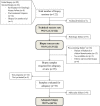Feasibility, safety, and adequacy of research biopsies for cancer clinical trials at an academic medical center
- PMID: 31404103
- PMCID: PMC6690517
- DOI: 10.1371/journal.pone.0221065
Feasibility, safety, and adequacy of research biopsies for cancer clinical trials at an academic medical center
Abstract
Objective: Research biopsies are an essential component of cancer clinical trials for studying drug efficacy and identifying biomarkers. Site-level clinical investigators, however, do not have access to results on the adequacy of research biopsies for histological or molecular assays, because samples are sent to central labs and the test results are seldom reported back to site-level investigators unless requested. We evaluated the feasibility, safety, and adequacy of research biopsies performed at an academic medical center.
Materials and methods: We retrospectively reviewed the data on 122 research biopsy sessions conducted in 99 patients via percutaneous core needle biopsy for 39 clinical trials from January 2017 to February 2018 at a single institute. We asked the sponsors of each clinical trial for the adequacy of the biopsy samples for histological or molecular assays.
Results: The biopsy success rate was 93.4% (113/122), with nine samples categorized as inadequate for obtaining pathologic diagnosis. Post-biopsy complications occurred in 9.8% (12/122) of biopsies, all of which were mild and completely recovered by the day after the biopsy. The sponsors of clinical trials provided feedbacks on the adequacy of 76 biopsy samples, and noted that a total of 8 biopsy samples from 7 patients were inadequate for analysis, resulting in an adequacy rate of 89.5% (68/76): the reasons for inadequacy were insufficient tumor content for immunohistochemistry (n = 3) and low RNA yield for sequencing (n = 5).
Conclusion: Research biopsies performed at an experienced, multidisciplinary center had acceptable safety for patients as well as practicality in terms of obtaining adequate tissue samples for molecular studies.
Conflict of interest statement
The authors have declared that no competing interests exist.
Figures
Similar articles
-
Feasibility and Safety of Intrathoracic Biopsy and Repeat Biopsy for Evaluation of Programmed Cell Death Ligand-1 Expression for Immunotherapy in Non-Small Cell Lung Cancer.Radiology. 2018 Apr;287(1):326-332. doi: 10.1148/radiol.2017170347. Epub 2017 Dec 12. Radiology. 2018. PMID: 29232184 Free PMC article.
-
Impact of touch imprint cytology on imaging-guided core needle biopsies: An experience from a large academic medical center laboratory.Diagn Cytopathol. 2016 Feb;44(2):87-90. doi: 10.1002/dc.23389. Epub 2015 Nov 23. Diagn Cytopathol. 2016. PMID: 26592851
-
Lessons learned from clinical trial queries on small biopsy collections: importance of rapid on-site evaluation.J Am Soc Cytopathol. 2020 Sep-Oct;9(5):461-468. doi: 10.1016/j.jasc.2020.04.012. Epub 2020 May 6. J Am Soc Cytopathol. 2020. PMID: 32499137 Review.
-
Improving Adequacy of Small Biopsy and Fine-Needle Aspiration Specimens for Molecular Testing by Next-Generation Sequencing in Patients With Lung Cancer: A Quality Improvement Study at Dartmouth-Hitchcock Medical Center.Arch Pathol Lab Med. 2017 Mar;141(3):402-409. doi: 10.5858/arpa.2016-0096-OA. Epub 2016 Oct 20. Arch Pathol Lab Med. 2017. PMID: 27763790
-
Diagnostic value and accuracy of imprint cytology evaluation during image-guided core needle biopsies: Review of our experience at a large academic center.Diagn Cytopathol. 2015 Oct;43(10):773-9. doi: 10.1002/dc.23300. Epub 2015 Jun 27. Diagn Cytopathol. 2015. PMID: 26119885 Review.
Cited by
-
T-Cell Heterogeneity in Baseline Tumor Samples: Implications for Early Clinical Trial Design and Analysis.Front Immunol. 2022 Apr 27;13:760763. doi: 10.3389/fimmu.2022.760763. eCollection 2022. Front Immunol. 2022. PMID: 35558070 Free PMC article.
-
Enhanced Detection of Desmoplasia by Targeted Delivery of Iron Oxide Nanoparticles to the Tumour-Specific Extracellular Matrix.Pharmaceutics. 2021 Oct 12;13(10):1663. doi: 10.3390/pharmaceutics13101663. Pharmaceutics. 2021. PMID: 34683956 Free PMC article.
-
Analyses of the Rationale and Implementation of Research Biopsies in Oncology Clinical Trials at a Tertiary Cancer Center.Oncologist. 2021 Dec;26(12):1062-1070. doi: 10.1002/onco.13906. Epub 2021 Aug 4. Oncologist. 2021. PMID: 34286890 Free PMC article.
-
The Safety and Suitability of DNA Sequencing of Tissue Biopsies Performed on Patients Referred to a Phase I Unit.Cancers (Basel). 2024 Dec 20;16(24):4252. doi: 10.3390/cancers16244252. Cancers (Basel). 2024. PMID: 39766151 Free PMC article.
-
Refining Liver Biopsy in Hepatocellular Carcinoma: An In-Depth Exploration of Shifting Diagnostic and Therapeutic Applications.Biomedicines. 2023 Aug 21;11(8):2324. doi: 10.3390/biomedicines11082324. Biomedicines. 2023. PMID: 37626820 Free PMC article. Review.
References
-
- Gupta S. New techniques in image-guided percutaneous biopsy. Cardiovasc Intervent Radiol. 2004; 27: 91–104. - PubMed
Publication types
MeSH terms
LinkOut - more resources
Full Text Sources
Medical


